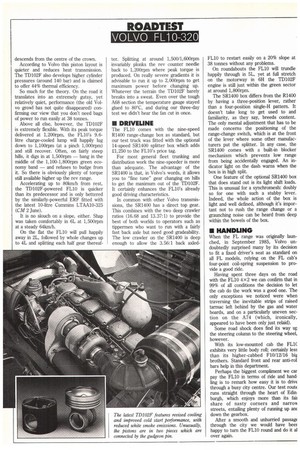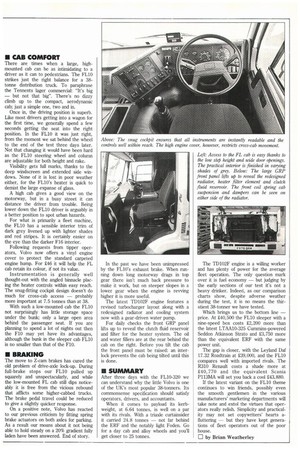ROADTEST VOLVO FL10-320
Page 46

Page 47

If you've noticed an error in this article please click here to report it so we can fix it.
descends from the centre of the crown_ According to Volvo this piston layout is quieter and reduces heat transmission. The TD102F also develops higher cylinder pressures (around 140 bar) and is claimed to offer 44% thermal efficiency.
So much for the theory. On the road it translates into an extremely gutsy, yet relatively quiet, performance (the old Volvo growl has not quite disappeared) confirming our view that you don't need bags of power to run easily at 38 tonnes.
Above all else, however, the TD102F is extremely flexible. With its peak torque delivered at 1,200rpm, the FL10's 9.6litre charge-cooled lump will happily lug down to 1,100rpm (at a pinch 1,000rpm) and still recover. Often, on fairly steep hills, it digs in at 1,500rpm — bang in the middle of the 1,100-1,800rpm green economy band — and refuses to budge from it. So there is obviously plenty of torque still available higher up the rev range.
Accelerating up to 80km/h from rest, the TD102F-powered FL10 is quicker than its predecessor and is only bettered by the similarly-powerful ERF fitted with the latest 10-litre Cummins LTAA10-325 (CM 2 June).
It is no slouch on a slope, either. Shap was taken comfortably in 6L at 1,5001pm at a steady 64km/h.
On the flat the FLIO will pull happily away in 2L, followed by whole changes up to 4L and splitting each half gear thereaf ter. Splitting at around 1,500/1,600rpm invariably plonks the rev counter needle back to 1,200rpm where peak torque is produced. On really severe gradients it is advisable to run it up to 2,000rpm to get maximum power before changing up. Whatever the terrain the TD102F barely breaks into a sweat. Even over the tough A68 section the temperature gauge stayed glued to 80°C, and during our three-day test we didn't hear the fan cut in once.
• DRIVELINE
The FL10 comes with the nine-speed R1400 range-change box as standard, but our test truck was fitted with the optional 14-speed SR1400 splitter box which adds 21,250 to the FLIO's price tag.
For most general fleet trunking and distribution work the nine-speeder is more than adequate. The advantage of the SR1400 is that, in Volvo's words, it allows you to "fine tune" gear changing on hills to get the maximum out cif the TD102F. It certainly enhances the FL10's already good driving characteristics.
In common with other Volvo transmissions, the SR1400 has a direct top gear. This combines with the two deep crawler ratios (16.68 and 13.37:1) to provide the best of both worlds to operators such as tippermen who want to run with a fairly fast back axle but need good gradeability. The low crawler on the SR1400 is deep enough to allow the 3.56:1 back aided FL10 to restart easily on a 20% slope at 38 tonnes without any problems.
On roundabouts the FL10 will trundle happily through in 5L, yet at full stretch on the motorway in 6H the TD102F engine is still just within the green sector at around 1,800rpm.
The SR1400 box differs from the R1400 by having a three-position lever, rather than a four-position single-H pattern. It doesn't take long to get used to and familiarity, as they say, breeds content. The only mental adjustment that has to be made concerns the positioning of the range-change switch, which is at the front of the lever where some other manufacturers put the splitter. In any case, the SR1400 comes with a built-in bbcker mechanism which prevents low range from being accidentally engaged. An indicator light on the dash warns when the box is in high split.
One feature of the optional SR1400 box that does stand out is its light shift loads. This is unusual for a synchromesh: doubly so for one with such a stubby lever. Indeed, the whole action of the box is light and well defined, although it's important not to rush the range change or a graunching noise can be heard from deep within the bowels of the box.
• HANDLING
When the FL range was originally launched, in September 1985, Volvo undoubtedly surprised many by its decision to fit a fixed driver's seat as standard on all FL models, relying on the FL cab's four-point coil-spring suspension to provide a good ride.
Having spent three days on the road with the FL10 4x2 we can confirm that in 99% of all conditions the decision to let the cab do the work was a good one. The only exceptions we noticed were when traversing the inevitable strips of raised tarmac left behind by the gas and water boards, and on a particularly uneven section on the A74 (which, ironically, appeared to have been only just relaid).
Some road shock does find its way tic the steering column to the steering wheel, however.
With its low-mounted cab the FL1C exhibits very little body roll; certainly lest than its higher-cabbed F10/12/16 bii brothers. Standard front and rear anti-rot bars help in this department.
Perhaps the biggest compliment we car pay the FL10 in terms of ride and handling is to remark how easy it is to drive through a busy city centre. Our test route runs straight through the heart of Edin. burgh, which enjoys more than its fail share of nasty corners and narrom streets, entailing plenty of running up am down the gearbox.
After a smooth and unhurried passage through the city we would have beet happy to turn the FL10 round and do it al over again.
• CAB COMFORT
There are times when a large, highmounted cab can be as intimidating to a driver as it can to pedestrians. The FL10 strikes just the right balance for a 38tonne distribution truck. To paraphrase the Tennents lager commercial: "It's big — but not that big". There's no dizzy climb up to the compact, aerodynamic cab; just a simple one, two and in.
Once in, the driving position is superb. Like most drivers getting into a wagon for the first time, we generally spend a few seconds getting the seat into the right position. In the FL10 it was just right, from the moment we sat behind the wheel to the end of the test three days later. Not that changing it would have been hard as the FL10 steering wheel and column are adjustable for both height and rake.
Visibility gets full marks, thanks to the deep windscreen and extended side windows. None of it is lost in poor weather either, for the FL10's heater is quick to demist the large expanse of glass.
A high cab gives a good view on the motorway, but in a busy street it can distance the driver from trouble. Being lower down the FL10 driver is arguably in a better position to spot urban hazards.
For what is primarily a fleet machine, the FL10 has a sensible interior trim of dark grey livened up with lighter shades and red stripes. It is certainly easier on the eye than the darker F16 interior.
Following requests from tipper operators, Volvo now offers a vinyl engine cover to protect the standard carpeted engine hump. For £46 it will help the FL cab retain its colour, if not its value.
Instrumentation is generally well thought-out with the angled binnacle placing the heater controls within easy reach. The snug-fitting cockpit design doesn't do much for cross-cab access — probably more important at 7.5 tonnes than at 38.
With such a low-mounted cab the FL10 not surprisingly has little storage space under the bunk; only a large open area behind the passenger seat. If you are planning to spend a lot of nights out then the F10 may yet have its advantages, although the bunk in the sleeper cab FL10 is no smaller than that of the F10.
• BRAKING
The move to Z-cam brakes has cured the old problem of drive-axle lock-up. During full-brake stops our FL10 pulled up squarely and unspectacularly, and while the low-mounted FL cab still dips noticeably it is free from the vicious rebound that afflicts some higher-cabbed trucks. The brake pedal travel could be reduced to give a slightly quicker response.
On a positive note, Volvo has reacted to our previous criticism by fitting spring brake actuators on both axles for parking. As a result our moans about it not being able to hold steady on a 20% gradient fully laden have been answered. End of story. In the past we have been unimpressed by the FL10's exhaust brake. When running down long motorway drags in top gear there isn't much back pressure to make it work, but on steeper slopes in a lower gear when the engine is revving higher it is more useful.
The latest TD102F engine features a revised turbocharger layout along with a redesigned radiator and cooling system now with a gear-driven water pump.
For daily checks the front GRP panel lifts up to reveal the clutch fluid reservoir and filter for the heater system. The oil and water fillers are at the rear behind the cab on the right. Before you tilt the cab the front panel must be raised: an interlock prevents the cab being tilted until this is done.
• SUMMARY
After three days with the FL10-320 we can understand why the little Volvo is one of the UK's most popular 38-tonners. Its commonsense specification should satisfy operators, drivers, and accountants.
When it comes to payload its kerbweight, at 6.64 tonnes, is well on a par with its rivals. With a triaxle curtainsider it carried 24.8 tonnes — not far behind the ERF and the notably light Foden. Go for a day cab and alloy wheels and you'll get closer to 25 tonnes. Left: Access to the FL cab is easy thanks to the low step height and wide door openings. The practical interior is finished in varying shades of grey. Below: The large GRP front panel lifts up to reveal the redesigned radiator, heater filter element and clutch fluid reservoir. The front coil spring cab suspension and dampers can be seen on either side of the radiator.
The TD102F engine is a willing worker and has plenty of power for the average fleet operation. The only question mark over it is fuel economy — but judging by the early sections of our test it's not a heavy drinker. Indeed, as our comparison charts show, despite adverse weather during the test, it is no means the thirstiest 38-tonner we have tested.
Which brings us to the bottom line — price. At £40,500 the FL10 sleeper with a nine-speed box costs £2,200 more than the latest LTAA10-325 Cummins-powered Seddon Atkinson Strata and £3,750 more than the equivalent ERF with the same power unit.
The gap is closer, with the Leyland Daf 17.32 Roadtrain at £39,000, and the FL10 compares well with imported rivals. The R310 Renault costs a shade more at £40,770 and the equivalent Scania P113MA will set you back a cool £43,880.
If the latest variant on the FL10 theme continues to win friends, possibly even the smooth gentlemen in the various manufacturers' marketing departments will take note and extol the virtues that operators really relish. Simplicity and practicality may not set copywriters' hearts a
fluttering but they have kept generations of fleet operators out of the poor house.
by Brian Weatherley














































































